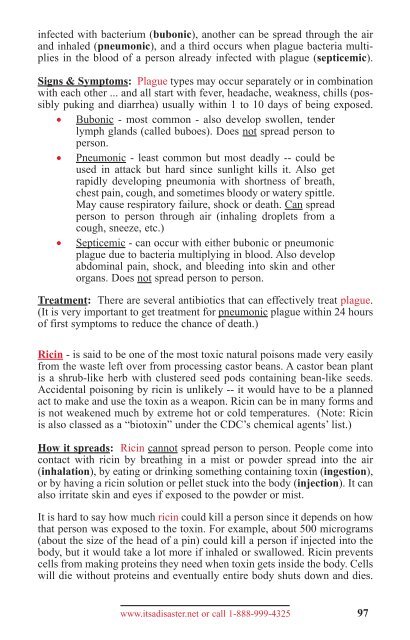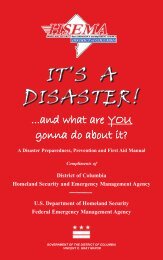disaster 5th 1108_5th ed 2011 - Homeland Security and Emergency ...
disaster 5th 1108_5th ed 2011 - Homeland Security and Emergency ...
disaster 5th 1108_5th ed 2011 - Homeland Security and Emergency ...
You also want an ePaper? Increase the reach of your titles
YUMPU automatically turns print PDFs into web optimized ePapers that Google loves.
infect<strong>ed</strong> with bacterium (bubonic), another can be spread through the air<br />
<strong>and</strong> inhal<strong>ed</strong> (pneumonic), <strong>and</strong> a third occurs when plague bacteria multiplies<br />
in the blood of a person already infect<strong>ed</strong> with plague (septicemic).<br />
Signs & Symptoms: Plague types may occur separately or in combination<br />
with each other ... <strong>and</strong> all start with fever, headache, weakness, chills (possibly<br />
puking <strong>and</strong> diarrhea) usually within 1 to 10 days of being expos<strong>ed</strong>.<br />
• Bubonic - most common - also develop swollen, tender<br />
lymph gl<strong>and</strong>s (call<strong>ed</strong> buboes). Does not spread person to<br />
person.<br />
• Pneumonic - least common but most deadly -- could be<br />
us<strong>ed</strong> in attack but hard since sunlight kills it. Also get<br />
rapidly developing pneumonia with shortness of breath,<br />
chest pain, cough, <strong>and</strong> sometimes bloody or watery spittle.<br />
May cause respiratory failure, shock or death. Can spread<br />
person to person through air (inhaling droplets from a<br />
cough, sneeze, etc.)<br />
• Septicemic - can occur with either bubonic or pneumonic<br />
plague due to bacteria multiplying in blood. Also develop<br />
abdominal pain, shock, <strong>and</strong> ble<strong>ed</strong>ing into skin <strong>and</strong> other<br />
organs. Does not spread person to person.<br />
Treatment: There are several antibiotics that can effectively treat plague.<br />
(It is very important to get treatment for pneumonic plague within 24 hours<br />
of first symptoms to r<strong>ed</strong>uce the chance of death.)<br />
Ricin - is said to be one of the most toxic natural poisons made very easily<br />
from the waste left over from processing castor beans. A castor bean plant<br />
is a shrub-like herb with cluster<strong>ed</strong> se<strong>ed</strong> pods containing bean-like se<strong>ed</strong>s.<br />
Accidental poisoning by ricin is unlikely -- it would have to be a plann<strong>ed</strong><br />
act to make <strong>and</strong> use the toxin as a weapon. Ricin can be in many forms <strong>and</strong><br />
is not weaken<strong>ed</strong> much by extreme hot or cold temperatures. (Note: Ricin<br />
is also class<strong>ed</strong> as a “biotoxin” under the CDC’s chemical agents’ list.)<br />
How it spreads: Ricin cannot spread person to person. People come into<br />
contact with ricin by breathing in a mist or powder spread into the air<br />
(inhalation), by eating or drinking something containing toxin (ingestion),<br />
or by having a ricin solution or pellet stuck into the body (injection). It can<br />
also irritate skin <strong>and</strong> eyes if expos<strong>ed</strong> to the powder or mist.<br />
It is hard to say how much ricin could kill a person since it depends on how<br />
that person was expos<strong>ed</strong> to the toxin. For example, about 500 micrograms<br />
(about the size of the head of a pin) could kill a person if inject<strong>ed</strong> into the<br />
body, but it would take a lot more if inhal<strong>ed</strong> or swallow<strong>ed</strong>. Ricin prevents<br />
cells from making proteins they ne<strong>ed</strong> when toxin gets inside the body. Cells<br />
will die without proteins <strong>and</strong> eventually entire body shuts down <strong>and</strong> dies.<br />
www.itsa<strong>disaster</strong>.net or call 1-888-999-4325<br />
97





